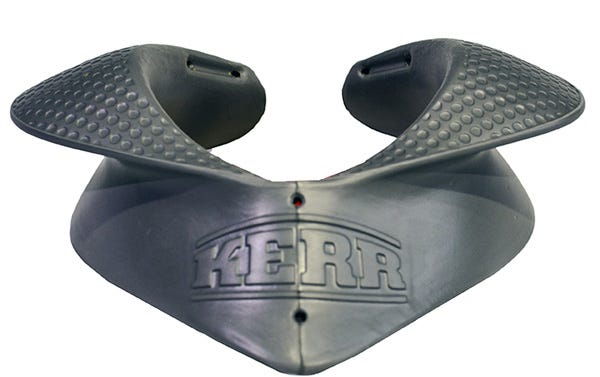A Device to Tackle Football's Concussion Problem
August 19, 2015
The thing with football, it just takes one hit for athletes to face a severe head and neck injury that could threaten their career and possibly life. A company has a device that it hopes can help athletes of nearly all ages, and possibly even help save the sport.
Brian Buntz
|
The Kerr collar was invented help reduce impact to the head and neck in football. |
"You have 8 to 13 kids who are either paralyzed or even killed from a broken neck in football every year," says Patrick Kerr, founder of Kerr Sports LLC (New York City) and a practicing chiropractor at Atlas Orthogonal of New York. "The nature of collisions in football is that you are going to have them in every practice and in every game. And probably one half of a percent of the players have neck protection."
A potential $1 billion NFL concussion settlement has helped bring public awareness to the problem at the pro level, when attorneys representing 5000 retired players sued the organization. A recent U.S. News & World Report article predicts that, unless something changes, the sport may face a slow and steady decline.
Kerr, who played football in high school and college, has invented a device to address the sports head and neck injuries. If left unaddressed, the problem could mean that a significant number of players face unnecessary injuries while the quality of the game gradually deteriorates. "What makes the NFL so amazing is that they have tremendous athletes making tremendous plays. But ultimately, if you don't retain the caliber of athletes, you are going to lose your product over time," he says. "Let's say a great young athlete wants to play football, but his mother pushes him to play soccer or track. Eventually, you might see a lesser quality of players in college and it's going to trickle down to the NFL."
Kerr's solution is known as the Kerr Collar, a device that can reduce force transmission by 58% to the neck, according to research carried out at the Virginia Tech Center for Biomechanics. The device serves as a sort of bridge between helmets and shoulder pads, and works by absorbing and transferring forces away from the head and neck.
"Without the Kerr collar, any forces that go to the helmet, get displaced to the head and the neck," Kerr explains. But with the device, as a player braces for impact and contracts his trapezius muscles as a reflex, the collar is pushed from above the shoulder pads to the helmet, deflecting and absorbing much of the impact. "We have created a system where the helmet interacts with the shoulder pads," Kerr says.
"In football, it is very different than NASCAR where you can create a HANS (Head and Neck Support) device, where the driver isn't really turning his head too much," Kerr says. "In my opinion, I don't think we'll ever have a football helmet and shoulder pad system attached together."
When scouring the products available for protecting football player's necks, Kerr didn't find anything that he felt offered acceptable protection.
So he went back to a makeshift device he made while playing high school football. "I would use an Adams neck roll, which was soft, and taped it down to make it harder," Kerr recalls. "Without knowing what I was doing, I placed it specifically underneath the helmet so that when I was bracing for impact, I would make sure that the makeshift device was up against the bottom of my helmet. And as we collided, that force would be transferred."
After he became a chiropractor, he started working on optimizing the design, exploring various materials and sizes, trying to make it work as a universal neck protection device that would be compatible with various shoulder pads and helmets.
The current version, which comes in M, L, and XL sizes, is made of a material known as Impax, which is made from a company called Der-Tex. "It is a proprietary lightweight material that is not a closed cell foam," Kerr says. "And it absorbs and disperses forces rather than pushing back like a polyurethane might do.
He first started testing the device in 2006, and it continues to be tested in crash tests and other types of research. "We have tested as much as you could possibly test it in the lab," Kerr says. "The tests we did at the Virginia Tech Center for Biomechanics were some of the first dynamic neck testing that has ever been done in football. Now, we are now working with North Carolina Chapel Hill to get an on-the-field research study together that would involve equipping their players with sensors."
Kerr says that every professional team uses at least some Kerr collars. "The pros don't disclose who is using it. And you can't really see it on the field because the jersey covers it," Kerr says. "We know certainly there are at least two players on every NFL team using it.
"Right now, the NFL is using it as an injury device. So if a player gets a stinger, or has a history of head and neck injury, they use the device," Ker says. "But we really want to push for having the device put on preventatively before the injuries take place."
Ultimately, he is working on developing an entire protocol designed to ensure that athletes are not getting needlessly injured.
Kerr plans on doing more research to better understand how to optimize the device. "We are not afraid to change the dimensions or the material because it is really about potentially saving a young man's life. This is only the beginning of a system, but it is certainly a good step forward."
Learn more about cutting-edge medical devices at MD&M Philadelphia, October 7-8, 2015. |
Like what you're reading? Subscribe to our daily e-newsletter.
About the Author(s)
You May Also Like



